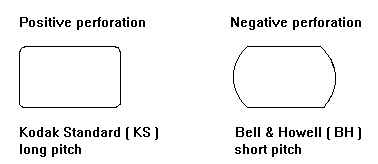Identifying Raw Stock.
We also have to learn to identify raw stocks by their physical characteristics.
We must know the colour of the base and the emulsion for each stock, and we must be able to recognise the differences between emulsion side and back as a precaution against errors.
Colour stocks
Colour stocks usually have a black coating on the base side of the film. This is called Remjet [ removable jet, i.e. carbon, backing] and is a dispersion of carbon particles in a binder. This is an anti-halation layer and prevents image light from the printing lamp, or camera lens, reflecting back from the base of the film into the picture area and reducing the edge definition and local contrast.. It has the additional advantage that it conducts static electrical charges and therefore prevents static from building up in the film. It also reduces the possibility of damage to the film base before processing as it can be marked or slightly damaged by handling but is completely removed at the start of processing.
Black and White film stocks have three colours of base.
1- Positive films such as Kodak 5302 or Agfa-Gevaert T5.61 [discontinued] have a clear base which appears off-white before processing.
2- Negative duplicating stocks such as Kodak 5234 or Agfa-Gevaert T4.64 have a blue base, which appears purple before processing.
3- Positive duplicating stocks such as Kodak 5366 or Agfa-Gevaert T3.62 have a clear base that appears yellow before processing.
Perforations
We discussed already the reasons for different
perforation pitches but you will also find that there are different
shapes of perforations. Over the years there have been many different
shapes of perforations for example Cinemascope perforations often
called 'Foxhole perfs'.
The two most common perforations that we use today for raw stock are Kodak Standard, abbreviated to KS. and Bell & Howell, abbreviated to BH.
Negative short pitch perfs are BH and positive long pitch perfs are KS.
